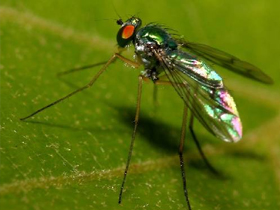One explanation offered for the origin of birds is the cursorial theory, according to which reptiles' forearms developed into wings as they needed speed in their attempts to catch insects. This theory lacks any scientific evidence. Moreover, insects are definitely able to fly, which means that evolutionists face the problem of the origin of insects. (See The Cursorial Theory.)
 A 145-million-year-old fossilized fly. There is no difference between this fossil, found in the Liaoning region of China, and modern flies of the same species. |
Flies emerge also suddenly and with their own unique structures in the fossil record. For example, a great many dragonfly fossils from the Pennsylvanian period have been discovered, all identical to present-day specimens.
The interesting fact here is that both dragonflies and flies appear at the same time as species of wingless insects. This invalidates the hypothesis that wingless insects gradually developed wings.
When insect fossils first appear, in the Middle and Upper Carboniferous, they are diverse and for the most part fully winged. There are a few primitively wingless forms, but no convincing intermediates are known.99
One important feature of those flies that emerge suddenly in the fossil record is their extraordinary flight techniques. Human beings cannot raise and lower their arms ten times a second, yet the average fly can flap its wings 500 times a second. Moreover, both wings beat simultaneously. The slightest irregularity in wing beats will upset the insect's balance, but this never occurs.
The better we understand the functioning of insect wings, the more subtle and beautiful their designs appear . . . Insect wings combine both in one, using components with a wide range of elastic properties, elegantly assembled to allow appropriate deformations in response to appropriate forces and to make the best possible use of the air. They have few if any technological parallels--yet.100
99. R. J. Wootton, C. P. Ellington, "Biomechanics & the Origin of Insect Flight," Biomechanics in Evolution, ed. J. M. V. Rayner & R. J. Wootton, Cambridge: Cambridge University Press, 1991, p. 99.
100. J. Robin Wootton, "The Mechanical Design of Insect Wings," Scientific American, vol. 263, November 1990, p. 120.


